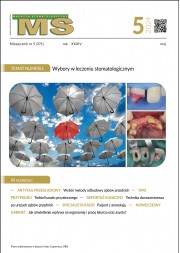Dostęp do tego artykułu jest płatny.
Zapraszamy do zakupu!
Cena: 6.15 PLN (z VAT)
Kup artykuł
Po dokonaniu zakupu artykuł w postaci pliku PDF prześlemy bezpośrednio pod twój adres e-mail.
Traditional formocresol vital pulpotomy in primary teeth and pulpotomy using a novel, bioactive cement Biodentine™
Magdalena Gońda-Domin, Anna Jarząbek, Ilona Wieczkowska, Karolina Węsierska, Rafał Rojek, Joanna Mikołajczyk
Magdalena Gońda-Domin, Anna Jarząbek, Ilona Wieczkowska, Karolina Węsierska, Rafał Rojek, Joanna Mikołajczyk
Streszczenie
Pulpotomia przyżyciowa jest jedną z najczęściej wykonywanych procedur endodontycznych w stomatologii dziecięcej. Na podstawie opisu dwóch przypadków klinicznych przedstawiono wskazania i przeciwwskazania do pulpotomii w zębie mlecznym oraz standardy postępowania w trakcie zabiegu amputacji formokrezolowej oraz z użyciem bioaktywnego cementu Biodentine™. Opisano specyfikę pracy z materiałem Biodentine™ i obecne poglądy na temat bezpieczeństwa pracy z zastosowaniem preparatu formokrezol.
Abstract
Vital pupotomy is one of the most frequently performed endodontic procedures in pediatric dentistry. On the basis of a description of two clinical cases, the indications and contraindications for pulpotomy in milk teeth were presented. A description was also given of the standards of procedure during treatment with formocresol pulpotomy and with the use of the novel bioactive cement Biodentine™. The characteristics of working with Biodentine™ material were described together with contemporary views about the subject of safety at work with the use of formocresol preparation.
Hasła indeksowe: pulpotomia, zęby mleczne, formokrezol, Biodentine™
Key words: pulpotomy, primary teeth, formocresol, Biodentine™
PIŚMIENNICTWO
1. American Academy of Pediatric Dentistry. Guideline on pulp therapy for primary and young permanent teeth. 2014, www. Aapd.org/media/policies.asp
2. Barańska-Gachowska M.: Endodoncja wieku rozwojowego i dojrzałego. Wyd. II. Wyd. Czelej, Lublin 2011.
3. Szpringer-Nodzak M.: Stomatologia wieku rozwojowego. Wyd. IV, Wyd. Lek. PZWL, Warszawa 2006.
4. Sonmez D., Sari S., Cetinbas T.: A comparison of four pulpotomy techniques in primary molars: a long-term follow-up. J. Endod., 2008, 34, 950-955
5. Węglarz A., Olczak-Kowalczyk D.: Alternatywy dla użycia formokrezolu w leczeniu chorób miazgi w uzębieniu mlecznym – przegląd piśmiennictwa. Nowa Stomatol., 2015, 20, 2, 65-72.
6. Brandl A. i wsp.: Retrospektywna, porównawcza ocena kliniczna wyników leczenia miazgi zębów mlecznych metodą pulpotomii za pomocą formokrezolu, aldehydu glutarowego i siarczanu żelaza. Czas. Stomatol., 2010, 63, 1, 27-33.
7. Herman K., Składnik-Jankowska J., Fita K.: Obecne poglądy dotyczące leczenia amputacyjnego chorób miazgi zębów mlecznych. Dent. Med. Probl., 2010, 47, 2, 230-235.
8. Ketley C.E., Goodman J.R.: Formocresol toxicity: is there a suitable alternative for pulpotomy of primary molars? Int. J. Pediatr. Dent., 1991, 1, 2, 67-72.
9. Casas M.J. i wsp.: Do we still need formocresol in pediatric dentistry? J. Can. Dent. Assoc., 2005, 71, 10, 749-751.
10. Srinivasan V., Patchet C., Watwehause R.J.: Is here life after buckeyes formocresol? Part 1. Int. J. Pediatr. Dent., 2006, 16, 117-127.
11. Srinivasan V., Patchet C., Watwehause R.J.: Is there life after buckeyes formocresol? Part 2. Int. J. Pediatr. Dent., 2006, 16, 199-206.
12. Nowicka A. i wsp.: Response of human dental pulp capped with iodentine and mineral trioxide aggregate. J. Endod. 2013, 39, 6, 743-747.
13. Kusum B., Rakesh K., Richa K.: Clinical and radiographical evaluation of mineral trioxide aggregate, biodentine and propolis as pulpotomy madicaments in primary teeth. Restor. Dent. Endod., 2015, 40, 4, 276-285.
14. Koubi G. i wsp.: Clinical evaluation of performance and safety of a new dentine substitute, Biodentine, in restoration of posterior teeth – a prospective study. Clin. Oral Invest ., 2013, 17, 1, 243-249.













